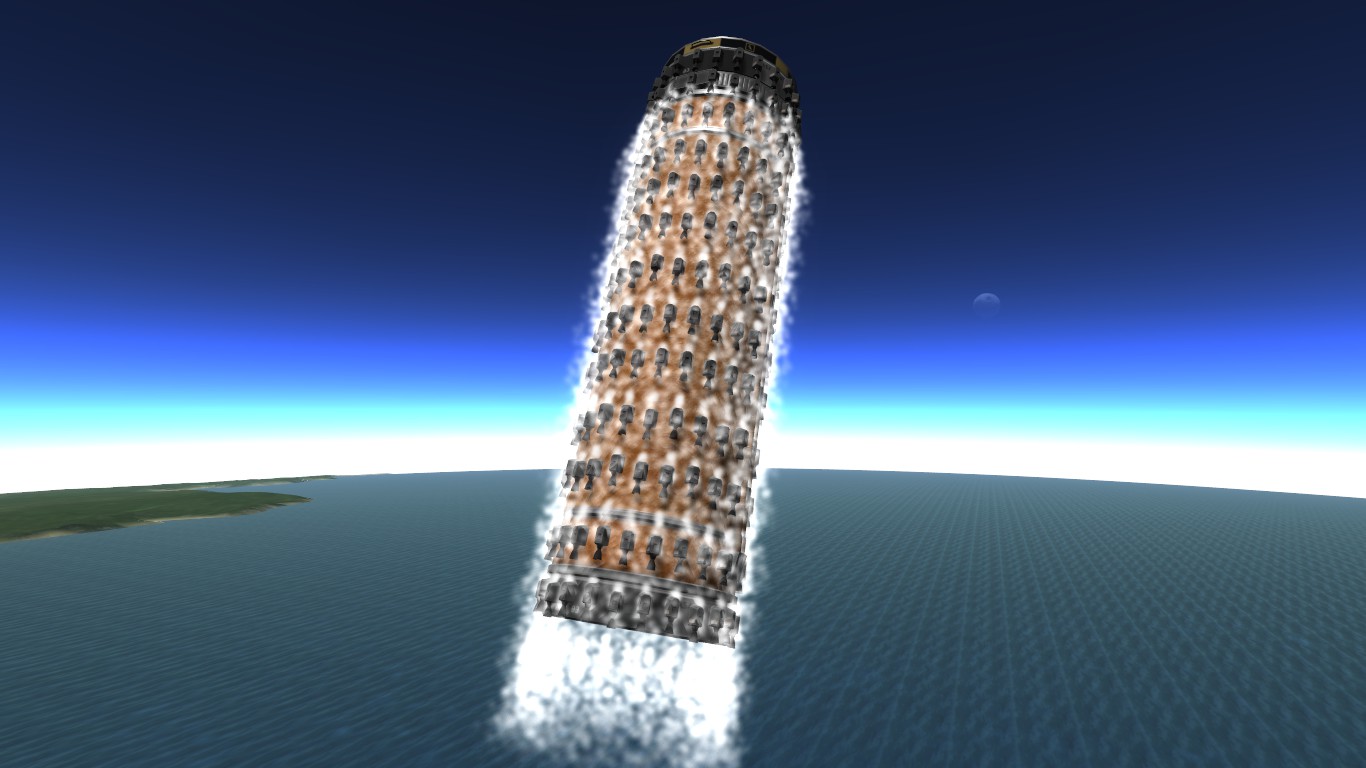Overview
Hello fellow rocket scientists!This table is a comparison of different engines firing the same vessel with the same azimuth (to zenith, more specifically). It shows overheat possibility, requirement of reaction wheels to maintain azimuth, need of batteries to keep the vessel running, kind and amount of engines, apoapsis altitude, maximum thrust and ascent thrust (to show how different burning rates afefct the ship).It’s, of course, still incomplete, and includes only the engines I care most. So don’t feel sad if yours isn’t here. Just talk it up and I’ll test it for you!
Test specifications
All tests were conducted with the same vessel, that can be seen under Picture 1.
Picture 1 – Standardized test vessel
The vessel is composed of fixed five parts and a variable sixth part:
- RC-L01 Remote Guidance Unit
- Z-4K Rechargeable Battery Bank
- Advanced S.A.S. Module, Large
- Rockomax Jumbo-64 Fuel Tank
- Advanced S.A.S. Module, Large
- Engine
The Engine part described above takes form of a single engine, an adapter and a cluster of engines or a cluster of radially mounted engines.
Tested engines were:
- 4x Toroidal Aerospike Rocket on a TVR-400L Stack Quad-Adapter
- 4x LV-T30 Liquid Fuel Engine on a TVR-400L Stack Quad-Adapter
- 4x LV-T45 Liquid Fuel Engine on a TVR-400L Stack Quad-Adapter
- Rockomax “Poodle” Liquid Engine
- 3x Rockomax Mark 55 Radial Mount Liquid Engine
- 4x Rockomax Mark 55 Radial Mount Liquid Engine
- 6x Rockomax Mark 55 Radial Mount Liquid Engine
- 8x Rockomax Mark 55 Radial Mount Liquid Engine
- 2x Rockomax BACC Solid Fuel Booster
- 4x Rockomax BACC Solid Fuel Booster
- 8x Rockomax BACC Solid Fuel Booster
- 16x Rockomax BACC Solid Fuel Booster
- 40x Rockomax BACC Solid Fuel Booster
- Rockomax “Mainsail” Liquid Engine at 87% power
- Rockomax “Mainsail” Liquid Engine at 53% power
- Rockomax “Skipper” Liquid Engine
- 312x LV-1R Liquid Fuel Engine
Note: Rockomax’ Mainsail at 87% maximum thrust was mounted directly on the Jumbo-64 tank, however, the Advanced SAS module pictured unmounted was mounted at the top, over the battery bank.
Test results
Below, the test results for the mentioned engine packages.
Table 1 – Test results
Notes:
- “Overheat issues” indicates if the engine package experimented, anytime during the constant thrust, constant azimuth ascent, overheating of the engines.
“n” means that everything went right at 100% throttle
“y” means the engined exploded due to overheating when tested. Test was conducted at redued throttle, indicated at the “Thrust” column.
‘~’ means that the engines showed some overheating at 100% throttle, but did not explode due to overheating during the ascent. - “SAS” and “Battery required” indicates if the vessel had need to use SAS to keep azimuth and if the vessel could be powered with engine-delivered electric charge. “y” means it need. “n” means it didn’t need.
Solid rocket boosters influence on ascent
Also, the impact of using solid booster rockets on a different vessel.
This one uses:
- 1 aerodynamic nose cone
- 1 remote control unit
- 1 jumbo-64 fuel tank
- 1 rockomax–>1m quad adapter
- 4 LV-T30 liquid engines
- 2 roundified monoprop tanks
- 8 thruster blocks
- 8 or 16 Rockomax’ BACCs mounted on the TT70 radial decoupler with Mk16xl chutes
Eight solids look like this:
Sixteen solids look like this:
At 250km, both had depleted all their fuel and were headed outside Kerbin’s sphere of influence.
Eight solids made the vessel travel at 3600 m/s
Sixteen solids made the vessel travel at 4060 m/s
Debriefing
So, this is it people. Any mistakes, additions or just Jebtalk, please, comment below!
Also, here’s some pics of the 312 LV-1Rs lifting the jumbo-64























